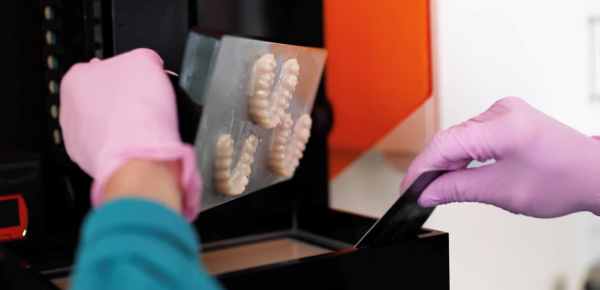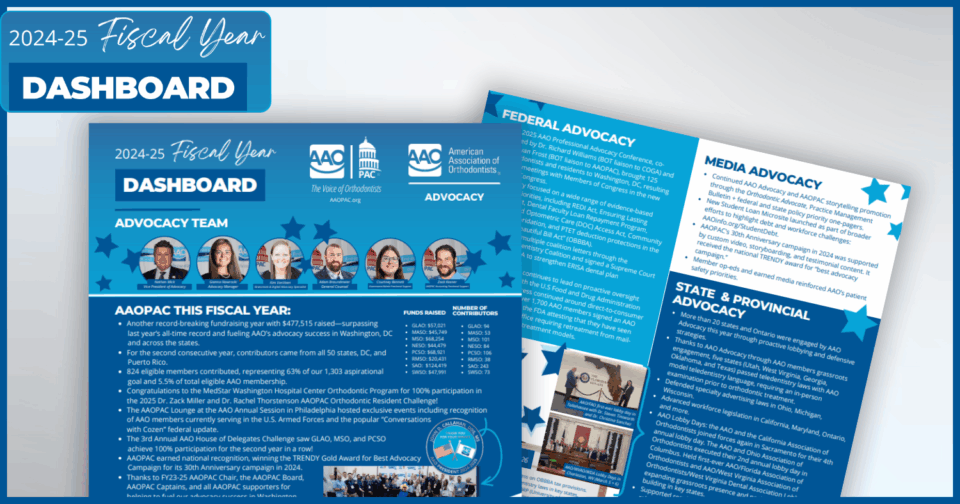The AAO surveyed U.S. and Canadian members on technology use earlier this year and is now reporting data from survey respondents.
The survey had three research objectives: 1) To determine what percentage of members are currently using 3D printers, intraoral scanners, digital indirect bonding, custom bracket systems, remote treatment monitoring, tooth movement software, digital workflow software, cone-beam computed tomography (CBCT) and robotic aligner trimmers and wirebenders, comparing results to a 2022 survey; 2) to understand barriers to adopting these technologies; and 3) to understand level of interest in adopting them.
In addition, survey questions addressed the purposes for which owners of 3D printers are using their printers, and barriers to fabricating aligners in-house. Highlights of survey responses included:
- Of the technologies included in the survey, intraoral scanner is the only one currently used by a majority of respondents (91%).
- The next most commonly used technologies were 3D printers (43%) and CBCT (42%).
- Nearly all respondents who use 3D printers do so for models for aligners (96%) while 55% use 3D printers for models for limited clear aligner cases.
- Those who use 3D printers for retainers but not for aligners provided a variety of reasons for this behavior with no consensus reason.
- Several tasks are completed by 20-30% of respondents using 3D printers, including models for full clear aligner cases (more than 14 sets of aligners) and models for initial aligners to start a patient, with remaining aligners outsourced. Some respondents also use 3D printers to produce nightguards and splints.
- Usage of some technologies, especially 3D printers, CBCT, and digital workflow software, are more likely among respondents younger than age 55.
- Practice modality also appears to influence the likelihood of using some technologies.
The survey report includes additional details of response data and demographic information about respondents.
View the Report
Respondents who are not using technologies discussed in the survey frequently cited the following issues:
- Detrimental to practice workflow and efficiency
- Not cost effective
- Staffing issues making it difficult to implement anything new
- Not user-friendly, difficult to implement
- Don’t know where to start
Explore Potential Return on Investment of Technology Acquisitions
Of the 57% of survey respondents who do not use 3D printers, for example, 74% considered the technology not cost effective and 55% expressed concerns around “Staffing issues making it difficult to implement anything new.” Although every technology is not right for every practice, AAO experts advise colleagues who have not done so to look closely at popular technologies that are otherwise of interest before discounting them.
Members of the AAO Committee on Technology (CTECH) have reported that costs have come down on some equipment and purchases may produce tax advantages at year end (check with your accountant for more information). When hiring, the digital tech position has been an easy one for CTECH members to fill because the younger demographic, being “digital natives” is a good fit in terms of skill set.
Regarding 3D printing of models for clear aligners, current CTECH Chair Dr. Lisa Alvetro and AAO trustee and former CTECH member Dr. Kenneth Webb point out that the high initial costs of assembling an in-house aligner lab can be justified by the improvements to efficiency, workflow and patient care.
“It is important to look at the lab cost as an investment in your practice,” says Dr. Alvetro. “We all have to keep our practices growing and look to the future and in our specialty, digital workflows are the future.”
“When you look at the per-case costs of using an outside lab to produce models and aligners versus in-house fabrication, the difference is night-and-day,” says Dr. Webb. Hear more from Drs. Alvetro and Webb in an AAO TechSelect video on financial considerations for in-house aligners.
Access the Financial Considerations Video
(Log-in will be required)
AAO TechSelect enables members to research and compare products and access a wealth of learning tools for implementation. TechSelect’s cost savings breakdown example provides detailed information about how costs for in-house aligner fabrication compare with those of using a third-party lab.
A payback calculator enables development of a customized projection beginning with investment (equipment and start-up supplies and tools), proceeding to net profit per case based on the fee entered, and concluding with the number of cases required to return investment costs.
Technologies Can Enhance Efficiency for Doctors and Teams (subhead)
To ease doctor and team learning processes and help ease workflow efficiency, TechSelect also includes detailed how-to written and video how-to guides for technologies with complex implementations, including 3D printing/in-house aligner fabrication and digital indirect bonding.
With 24% of respondents using digital indirect bonding, 72% of those not using it considered the technology not cost effective and 48% expressed the view that it would be “detrimental to practice workflow and efficiency.” Dr. Alverto says that the DIB set-up process is easy to learn and results in substantial increases in efficiency.
“The digital process makes all the difference in the efficiency of the workflow from beginning to end,” she says. “The software for digital set-ups is now very intuitive and makes it easy to place brackets with precision to get each tooth to the desired position.
Once the patient is seated in the chair, their bonding time is reduced by about half. It is easy to train staff to seat indirect bonding trays, or the doctor can do it. The process is completed by the chairside assistant curing the adhesive.”
Learn more about Dr. Alvetro’s experiences with DIB in the article,
“Digital Indirect Bonding Brings Efficiencies, Benefits for Patient and Doctor”
Enabling AAO member users toresearch and compare products and access a wealth of learning tools for implementation, TechSelect features only products from leading suppliers that have been vetted by the AAO Committee on Technology and agreed to be TechSelect partners. AAO members have access to the lowest available prices for featured products – available only through TechSelect.
TechSelect product categories include all technologies addressed in the AAO Technology survey except CBCT.



